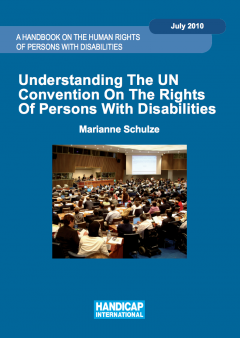A Handbook on the Human Rights of Persons with Disabilities, July 2010
The purpose of this manual is to explain the Convention on the Rights of Persons with Disabilities in the context of other core human rights treaties to strengthen its place in the mainstream of human rights discourse. As has frequently been emphasized: the Convention does not create any new rights. It does, however, highlight the accessibility and inclusion angle of all human rights. The manual goes through all the Articles of the Convention. It provides the narrative of the drafting process, whenever suitable and helpful to the general understanding of provisions. The bargaining and deals of a drafting process are a given and are therefore not dwelled on. Each Article is linked to similar provisions both in the Universal Declaration of Human Rights and the core human rights treaties. The interrelation between the various human rights treaties is spelled out in the Introduction.
Furthermore, most human rights have by now been subject to general explanations by expert bodies within the United Nations system. Wherever they seem helpful to gain a better understanding of the right, they have been included.
Most importantly, the manual gives a comprehensive – but by no means complete – overview of the positions taken by civil society, especially Disabled People’s Organizations (DPOs), and other stakeholders in the drafting process – as perceived by observers. Many of the suggestions provided by civil society, mainly through the International Disability Caucus (IDC) – which took shape in the negotiation process – are either summarized or provided in full. The civil society proposals are mainly those provided before the finalization of the Convention, all of them are taken from public domain.
The manual was first drafted for a training of NGOs and DPOs in Belgrade, Serbia in September 2007. Dr. Damjan Tatic, who subsequently took on the translation into Serbian with much admired bravery, commented on the initial draft with most helpful suggestions. The revision of said draft was supported by very useful remarks of Dr. Muhannad Alazzeh from Handicap International (a member of the IDC) in Amman. Both gentlemen had participated in the negotiations of the Convention, Dr. Tatic representing Serbia. Throughout the process of writing, Dr. Kirsten Young, who lent her expertise to the drafting process through Landmine Survivors Network (a member of the IDC also - now SurvivorCorps), shared her valuable insights and expertise. Finally, I wish to acknowledge Stefan Tromel, from the IDC who shared an unpublished commentary of the Convention. Notwithstanding the level of expert support, all errors remain the author’s.
The update of the Manual introduces a new section on “The Convention after 2006”, which highlights some of the key documents adopted by United Nations bodies following the adoption of the Convention. Furthermore, the importance of the obligation to involve DPOs (Article 4 (3)) has been further elaborated, among others.
I wish to acknowledge Alexandre Cote, then Director of Handicap International South East Europe program for kick-starting this project. My profuse thanks to Philippe Chervin and Catherine Dixon, Sophie Bonifas and Stéphanie Deygas for seeing this text through to publication. Various people have lent their support to the drafting of this manual, they are too numerous to list, I would like to thank them all.
- Marianne Schulze
